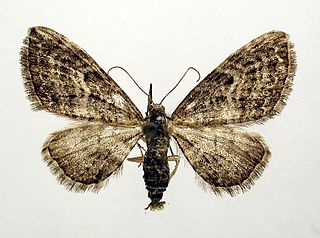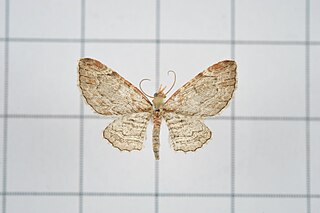
Eupithecia is the largest genus of moths of the family Geometridae, and the namesake and type genus of tribe Eupitheciini. Species in the genus are, like those of other genera in the tribe, commonly known as pugs. The genus is highly speciose, with over 1400 species, and members of the genus are present in most of the world with exception of Australasia. Roughly a quarter of described Eupithecia species occur in the Neotropical realm, where they have an especially high species diversity in the montane rain forests of the Andes. The genus includes a few agricultural pest species, such as the currant pug moth, Eupithecia assimilata, which is a pest on hops, and the cloaked pug moth, Eupithecia abietaria, which is a cone pest in spruce seed orchards.

The juniper pug or juniper looper is a moth of the family Geometridae. The species was first described by Michael Denis and Ignaz Schiffermüller in 1775. It is found throughout the Palearctic and in the Nearctic.

The larch pug is a moth of the family Geometridae. The species can be found in Europe, the Ural Mountains, West and Central Siberia, the Altai Mountains, Transbaikalia, Yakutia, the Far East, Mongolia, Korea, Japan and in North America, from Yukon and Newfoundland to New York and Arizona.

Mesoptila melanolopha is a moth in the family Geometridae first described by Charles Swinhoe in 1895. It is found in Nepal, China, Korea, Japan, Taiwan, India, Sri Lanka, Thailand, Vietnam, Malaysia and on Java, Bali and Borneo.

Eupithecia quadripunctata is a moth in the family Geometridae. It is found in India, Pakistan, Nepal, Russia, China, Taiwan, Korea, Japan and northern Thailand.

Eupithecia costalis is a moth in the family Geometridae first described by Francis Walker in 1863. It is widespread in the tropical and subtropical lowland regions of east and south-east Asia, from Taiwan to India, Sri Lanka Borneo, Borneo, to Hong Kong.
Girida rigida is a moth in the family Geometridae first described by Charles Swinhoe in 1892. It is found from the Ryukyu Islands through tropical and subtropical south-east Asia to New Caledonia. Records for eastern Africa refer to Girida sporadica, which was promoted to species rank in 2012.
Eupithecia nigrinotata is a moth in the family Geometridae first described by Charles Swinhoe in 1895. It is found in Nepal, Thailand and the Indian state of Assam.
Eupithecia amicula is a moth in the family Geometridae first described by Vladimir G. Mironov and Anthony Charles Galsworthy in 2005. It is found in south-western and western Chinese provinces of Sichuan, Yunnan and Shaanxi.
Eupithecia acolpodes is a moth in the family Geometridae. It is found in India and Pakistan. Vladimir Mironov and Anthony Galsworthy place the species as part of the sinuosaria species group.
Eupithecia amplexata is a moth in the family Geometridae. It is found in China, Russia and Japan.
Eupithecia jinboi is a moth in the family Geometridae. It is found in Japan.
Eupithecia maenamiella is a moth in the family Geometridae. It is found in Japan.
Eupithecia neosatyrata is a moth in the family Geometridae. It is found in Japan.
Eupithecia rufescens is a moth in the family Geometridae. It is found in Japan.
Eupithecia ryukyuensis is a moth in the family Geometridae. It is found in Japan.
Eupithecia shikokuensis is a moth in the family Geometridae. It is found in Japan.
Eupithecia subfumosa is a moth in the family Geometridae. It is found in Japan.
Eupithecia takao is a moth in the family Geometridae. It is found in Japan and Russia.
Eupithecia yakushimensis is a moth in the family Geometridae. It is found in Japan.





